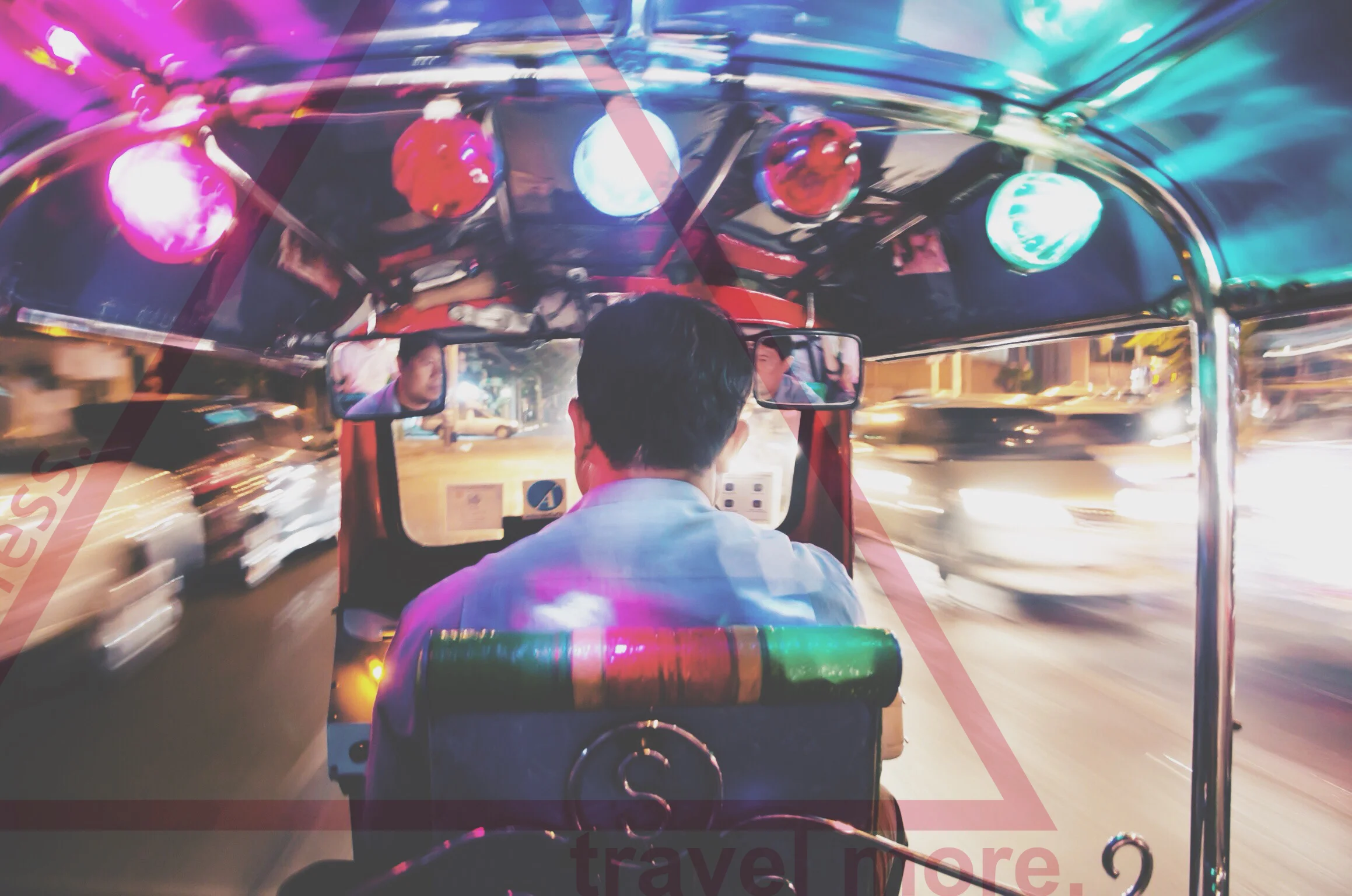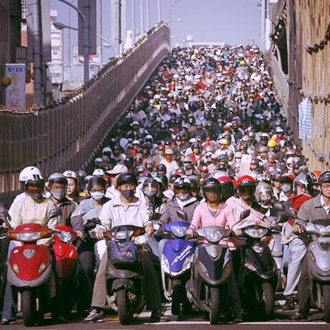










How To Survive A Drive In The Developing World. The Think Less. Travel More. Guide
HOW TO SURVIVE A DRIVE IN THE DEVELOPING WORLD.
a think less. travel more. guide
How To Survive A Drive In The Developing World. The Think Less. Travel More. Guide
HOW TO SURVIVE A DRIVE IN THE DEVELOPING WORLD.
a think less. travel more. guide
“During the past few years we’ve participated in our fair share of driving, walking, scootering and straight up running-for-dear-life in the developing world — we’re talking everywhere from India, Honduras, the Philippines and Zimbabwe to Vietnam, Mexico and Italy. (We know, we know Italy is technically not the “Third World”, but no one seems to have told the Italian motorists.)
While we’re not experts, we’ve got an editor on staff who has survived two scooter accidents, a bus hijacking, a pistol whipping, a head-on train collision and a jaywalking incident in Germany, amongst other hijinx.
And since our goal is to help you learn from our mistakes, we’ve asked her to share her notes with you, dear readers, so if you’re planning to do something really stupid with your Hertz #1 Card, this is the guide for you.”

ROAD HAZARDS. How To Stay Alive While Driving In Developing Countries.
NAVIGATING ROAD HAZARDS.
ROAD HAZARDS. How To Stay Alive While Driving In Developing Countries.
NAVIGATING ROAD HAZARDS.
What would be a road hazard anyplace else, is probably just "the road" in a developing country.
Really experienced drivers and powerless bus passengers know there are two techniques for coping with this. One is to drive as quickly as possible, picking up enough speed so that your vehicle sails over the ditches, speed bumps and other hazards.
Predictably, this will end in disaster.
For the more cautious in the bunch, technique number two is to drive very slow.
This will also result in disaster. No matter how slowly you drive into a ten foot hole, you’re still going to get hurt. (Unless you’re the bus driver, in which case you will cackle at your injured passengers and then disappear with your cronies-- most likely to get a drink).

LOGISTICS. How To Stay Alive While Driving In Developing Countries
LOGISTICS.
LOGISTICS. How To Stay Alive While Driving In Developing Countries
LOGISTICS.
It’s important to do your homework before you begin piloting a car around such a country.
For instance, which side of the road do they drive on? This is easy. They drive on your side.
Basically this means that regardless of the actual rules of the road, you can rest assured that any oncoming traffic will be closer to your side than you'd like.
Unless you’re driving manual in South Africa, in which case you’ll be driving on the wrong side on the wrong side of the car while trying to shift gears with your left hand (or reaching across to give it a yank with your right in case of approaching elephants or carjackers -- depending on your proximity to Johannesburg).
In cities, much of the driving is done on the sidewalks since most parking is done in the middle of the streets.
The only firm rule is: Armored personnel carriers have the right of way. Otherwise, feel free to play fast and loose.

TRAFFIC SIGNS & SIGNALS. How To Survive A Drive In The Developing World.
TRAFFIC SIGNS & SIGNALS.
TRAFFIC SIGNS & SIGNALS. How To Survive A Drive In The Developing World.
TRAFFIC SIGNS & SIGNALS.
Most developing nations use international traffic symbols, which look like Boy Scout merit badges.
Then there’s the international symbol for…. what was it? If you can tell us what an iguana silhouette with a red diagonal bar across it means, we’ll be forever grateful -- not that we plan to drive in Nicaragua again.
Don’t worry, the locals don’t know what they mean either.
Especially those responsible for ferrying you around in the white vans favored by tourists in 80% of developing countries. The natives do, however, have an elaborate set of symbols used to convey information to the traffic around them.
For example, if you’re trying to pass someone and she blinks her left turn signal, it means go ahead.
Either that, or it means a large truck is careening around the bend and you’ll get killed if you try. You’ll find out in a moment.
Deciphering the signals of motorists in countries like India, Guatemala and the Philippines is further complicated by festive decorations found on many vehicles.
It can be hard to tell a hazard flasher from a string of Christmas-tree lights wrapped around the bumper, and the red Jesus statuettes can be easily mistaken for brake lights.
Dangerous Curves.
Particularly perilous stretches of road are generally marked, at least in Christian countries, by white wooden crosses positioned in a way that only seems to make the curve even more dangerous.
These crosses are memorials to people who’ve died in traffic accidents, and they give a pretty scientific indication of how much trouble you’re likely to have at any given spot in the “road”.
Thus, if you mistake the brake lights for blinking Jesus figurines and come to a full-power slide anywhere near a forest of crucifixes, you know you’re dead.

DRIVE LIKE A LOCAL. A How To Guide By Think Less. Travel More.
MASTERING LOCAL ETIQUETTE.
DRIVE LIKE A LOCAL. A How To Guide By Think Less. Travel More.
MASTERING LOCAL ETIQUETTE.
It’s important to understand that in most countries, the majority of driving is done with the horn.
"Emotionally Your's" works his aggression out on the horn.
Also known as the “Indian brake pedal” by those who have survived a cross-country jaunt on the continent.
There is a precise and complicated etiquette, and the horn should be used only in the following circumstances:
When anything blocks the road.
When nothing blocks the road.
When anything might block the road.
At red lights.
At green lights (in celebration!).
At all other times.

ROADBLOCKS. How To Survive A Drive In The Developing World.
ROADBLOCKS, TOLLS & CHECKPOINTS.
ROADBLOCKS. How To Survive A Drive In The Developing World.
ROADBLOCKS, TOLLS & CHECKPOINTS.
One thing you can count on when traveling overland in a developing country is trouble.
There’s always some uprising and/or Marxist insurrection going on, and if there isn’t there’s probably someone entrepreneurial enough to have tossed together a “toll booth” to make a few bucks.
There are two kinds of military roadblocks:
The kind where you slow down so they can look you over, and the kind where you come to a full stop so they can steal your luggage.
The most important thing is that you must never stop at the slow-down kind of roadblock, because if you do they’ll think you’re a terrorist about to attack them and they’ll shoot you. But, my friends, you must always stop at the full-stop kind of roadblock. If you just slow down, they’ll think you’re a terrorist about to attack them and they’ll shoot you.
“The wise traveler will pack shirts with amble pockets at the chest. Reaching inside your jacket or glove compartment for your passport looks too much like going for the draw and puts armed men out of continence.”
How do you tell the difference between the two kinds?
Here’s the most exciting part: you can’t!
The exception? Israel, where you will be glad to confront the only armed maniacs in the Middle East who aren’t allowed to shoot U.S. citizens. If in doubt, whip you passport out, hold it at about shoulder high and calmly say, “American” until this is remembered.
(The terrorists of course have roadblocks of their own. They always make you stop. Sometimes with land mines.)

ANIMALS & PEDESTRIANS. How To Survive A Drive In A Developing Country
ANIMALS, THEN PEDESTRIANS. THE RIGHT OF WAY HIERARCHY.
ANIMALS & PEDESTRIANS. How To Survive A Drive In A Developing Country
ANIMALS, THEN PEDESTRIANS. THE RIGHT OF WAY HIERARCHY.
As a general rule of thumb, speed up for goats, slow down for donkeys and stop for cows.
It’s almost impossible to hit a goat, so drive like hell through them. On the other hand, it’s almost impossible not to hit a cow, and if you’re in India, this can mean big trouble.
Cows are immune to horn-honking, shouting, swatting and gentle taps with your bumper. The only thing you can to do make a cow move is to swerve to avoid it, which will make the cow move in front of you with lightening speed. Donkeys, on the other hand will get our of your way eventually, as will pedestrians.
That said, never, and I repeat, NEVER actually stop for either of them or they’ll take advantage of you, especially the pedestrians.
Show any sign of weakness at a crowded stop in the “Third World” and you’ll be stuck buying chiclets and prayer beads until a "dangerous curve" starts to sound like a good way to go.

CROSSING THE ROAD. How To Survive A Drive In A Developing Country.
CROSSING THE ROAD.
CROSSING THE ROAD. How To Survive A Drive In A Developing Country.
CROSSING THE ROAD.
If you should ever find yourself a pedestrian facing a real life game of frogger:
Quickly take stock of your surroundings- here's one place where cultural stereotypes come in handy.
Are you in Southeast Asia?
Your best bet is to walk calmly and confidently and a slow but consistent pace into oncoming scooter traffic. This makes it easier for motorists to judge your position in the road and thus easier to avoid you.
Find yourself on a freeway in India?
The only thing to do is to find a local, attach yourself to them, match their every step and/or weave and then when they run, run like hell.
Germany? Well, Germany is the worst.
Step one inch outside of the cross-walk and you’ll be nailed with a hefty jaywalking fine faster than you can say Oktoberfest.

ACCIDENTS. Surviving A Drive In A Developing Country.
ACCIDENTS.
ACCIDENTS. Surviving A Drive In A Developing Country.
ACCIDENTS.
The best way to avoid an accident? Never look where you’re going.
Trust us, you’ll only scare yourself. Nonetheless, try to avoid collisions as there are bound to be more people in that minibus, truck, or even on the front seat of that Moped than there are in your car.
At best, you’ll find yourself at the center of a screaming mob. Worst case scenario? You’ll become an unwilling participant in a centuries long blood feud, which is a popular hobby in many of these places.
If you do have an accident, the only thing to do is go on the offensive.
Start throwing big wads of crisp, unfolded American bills at everyone. Remember, the American embassy is probably occupied with that Marxist insurrection and it may be months before they come to your aid, so don’t forget to smile!

SAFETY TIPS. Surviving A Drive In A Developing Country.
SAFETY TIPS.
SAFETY TIPS. Surviving A Drive In A Developing Country.
SAFETY TIPS.
SINCE WE'RE ALL ABOUT FAIR AND BALANCED REPORTING,
WE'LL POINT OUT SOMETHING NICE THING ABOUT OVERLAND TRAVEL IN DEVELOPING COUNTRIES:
The laissez faire attitude towards seatbelts.
And while you're at it, add smoking to the list. And being sober behind the wheel. All of which can ease the load on you shoulders when the average life expectancy is all of five minutes.
A FINAL THOUGHT FOR THE ROAD..
IN CASE YOU HAVEN'T CAUGHT ON, DEAR READERS, THIS "GUIDE" WAS A JOKE.
Whether you thought it was a good joke or not is probably dependent on the depth of your own experience with transportation in developing countries.
For an entirely serious guide to the most common types of travel in these parts of the world, head on over to the Think Less. Travel More. Transportation Cheat Sheet, which you can find here.
Or, visit our list of destinations with the w̶o̶r̶s̶t̶ Most Exciting Local Transport, for a real life crash course that's all your own (pun intended, of course).
Happy travels,
WE'RE A NEW SITE, AND EVERY SHARE COUNTS.
Like what you read? Give us a share on Facebook by clicking the handy button on the bottom right ⤀





